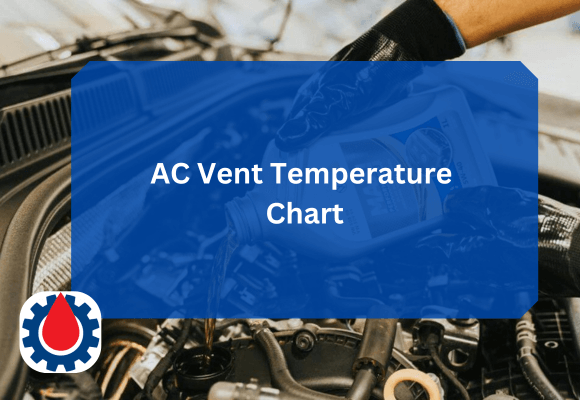Monitoring the AC vent temperature helps determine if the system is functioning efficiently or if there’s a problem with refrigerant charge, compressor, or airflow.
This guide provides a comprehensive AC vent temperature chart and explanations of what different readings mean under various conditions.
AC Vent Temperature Chart
| Ambient Temperature (°F) | Ambient Temperature (°C) | Expected Vent Temperature (°F) | Expected Vent Temperature (°C) | Condition/Remarks |
|---|---|---|---|---|
| 65°F | 18°C | 36–40°F | 2–4°C | Excellent — very efficient cooling |
| 70°F | 21°C | 38–42°F | 3–6°C | Excellent cooling performance |
| 75°F | 24°C | 40–45°F | 4–7°C | Normal operation |
| 80°F | 27°C | 42–48°F | 6–9°C | Slightly warm air, still acceptable |
| 85°F | 29°C | 44–50°F | 7–10°C | Ideal range for most systems |
| 90°F | 32°C | 46–52°F | 8–11°C | Normal performance in high ambient temperature |
| 95°F | 35°C | 48–54°F | 9–12°C | Warm climate performance; system under load |
| 100°F | 38°C | 50–56°F | 10–13°C | Slightly warmer due to high ambient load |
| 105°F | 41°C | 52–58°F | 11–14°C | Hot ambient—acceptable for high heat conditions |
| 110°F | 43°C | 54–60°F | 12–15°C | Efficiency begins to drop slightly |
| 115°F | 46°C | 56–62°F | 13–16°C | Typical for desert/high heat driving |
| 120°F | 49°C | 58–64°F | 14–18°C | System near maximum limit |
| 125°F | 52°C | 60–68°F | 15–20°C | Indicates very hot ambient or minor cooling issue |
| 130°F | 54°C | 62–70°F | 16–21°C | Cooling performance slightly reduced |
| 135°F | 57°C | 64–72°F | 17–22°C | Marginal cooling — check refrigerant and condenser |
| 140°F | 60°C | 66–74°F | 18–23°C | System under extreme stress, reduced efficiency |
| 145°F | 63°C | 68–76°F | 20–24°C | May indicate low refrigerant or compressor weakness |
| 150°F | 66°C | 70–78°F | 21–25°C | Hot ambient limit — potential overheat zone |
| 155°F | 68°C | 72–80°F | 22–27°C | Cooling efficiency significantly reduced |
| 160°F | 71°C | 74–82°F | 23–28°C | Poor cooling — check system performance |
| 165°F | 74°C | 76–84°F | 24–29°C | System unable to keep up — service needed |
| 170°F | 77°C | 78–86°F | 25–30°C | Overheated system — compressor may shut off |
| 175°F | 79°C | 80–88°F | 26–31°C | Cooling lost — possible AC component failure |
| 180°F | 82°C | 82–90°F | 27–32°C | AC system non-functional, immediate inspection needed |
Related Transmission Fluid Temperature Chart(Comprehensive Guide)
Additional AC Performance Conditions
| Parameter | Recommended Condition |
|---|---|
| Engine RPM | 1500–2000 RPM (not idle) |
| Fan Speed | Maximum |
| AC Mode | Recirculate |
| Temperature Control | Full cold |
| Doors/Windows | Closed |
| Ambient Temp | Measure before test |
| Measurement Tool | Digital thermometer at center vent |
Related Diesel Engine Oil Temperature Chart(Comprehensive Guide)
Normal vs Abnormal Vent Temperatures
| Vent Temperature (°F) | Condition | Possible Cause |
|---|---|---|
| 35–45°F | Excellent | System working efficiently |
| 45–55°F | Normal | Acceptable under most conditions |
| 55–65°F | Warm air | Slightly low refrigerant or airflow issue |
| 65–75°F | Too warm | Low refrigerant, weak compressor, or expansion valve fault |
| 75°F+ | Hot air | Compressor not engaging or system failure |
Why AC Vent Temperature Matters
Monitoring the vent temperature helps identify the efficiency of your car’s air conditioning system. If the air is not cold enough, it could indicate:
- Low refrigerant level
- Dirty condenser or evaporator
- Clogged cabin air filter
- Weak compressor
- Faulty expansion valve or orifice tube
- High ambient humidity reduces cooling efficiency
A well-performing AC system should lower the vent temperature quickly after startup and maintain it consistently, even in hot conditions.
Related Normal Engine Oil Temperature(Find Out the Safe Range)
Tips to Maintain Proper Vent Temperature
- Clean the condenser and evaporator: Dust and debris restrict airflow and raise vent temperature.
- Check refrigerant charge: Ensure proper level using gauges; undercharge or overcharge affects cooling.
- Replace cabin air filter regularly: Dirty filters restrict airflow and reduce cooling output.
- Use recirculation mode: Recirculates cool air inside the cabin for faster and colder output.
- Avoid idling tests: AC efficiency drops at idle, test under driving RPM conditions.
- Service regularly: Routine AC inspection helps maintain refrigerant quality and compressor health.
Related Car AC Gauge Reading Chart(Complete Guide)
Troubleshooting Common Vent Temperature Problems
| Issue | Possible Cause | Fix |
|---|---|---|
| Warm air at idle | Weak compressor or low refrigerant | Check refrigerant level, test compressor clutch |
| Cold at speed, warm at idle | Condenser airflow issue | Clean or replace condenser fan |
| Uneven cooling | Blend door malfunction | Inspect blend door actuator |
| Fluctuating cold/hot air | Faulty expansion valve | Replace valve and recharge refrigerant |
| No cold air at all | Compressor failure | Professional AC service required |
Related AC System Pressure Chart(For All Refrigerant Types)
FAQs
What temperature should your AC be at the vent?
The ideal AC vent temperature in most vehicles should range between 38°F and 50°F (3°C–10°C) when measured at the center vent with the system on maximum cooling and recirculation mode. This range ensures efficient cooling performance. If the temperature is above 55°F (13°C), it could indicate issues such as low refrigerant, restricted airflow, or compressor problems.
How to check AC vent temperature?
To accurately measure your AC vent temperature, follow these steps:
- Start the engine and let it idle for 5 minutes.
- Set the AC to maximum cooling and recirculation mode.
- Increase engine RPM to around 1500–2000 (not idle).
- Insert a digital thermometer into the center of the AC vent.
- Record the reading after 2–3 minutes.
A properly working system should show readings between 38°F and 50°F (3°C–10°C) under normal ambient conditions.
Is 27 degrees hot or cold on AC?
A setting of 27°C (about 81°F) on your air conditioner is considered warm, not cold. It’s typically used for maintaining comfort without overcooling. For cooling efficiency, most people set their AC between 22°C and 25°C (72°F–77°F) indoors. In vehicles, however, air from the vents should be much colder, around 5°C–10°C (41°F–50°F), to quickly cool the cabin.
What should the temperature be at the center outlet of the AC vent?
The center vent outlet temperature should ideally fall between 38°F and 45°F (3°C–7°C) when tested under normal ambient conditions (around 75°F to 85°F). This indicates that the compressor, refrigerant charge, and airflow are working efficiently. Temperatures above 50°F (10°C) suggest the system may need servicing.
Should AC vents be high or low?
In most vehicles and home systems, AC vents should be positioned high on the wall or dashboard. Cold air is denser and sinks naturally, so placing vents high allows the cool air to circulate downward efficiently.
For heating systems, vents are often placed low to allow warm air to rise and distribute evenly. In cars, dashboard vents (high placement) are optimal for fast and balanced cabin cooling.




